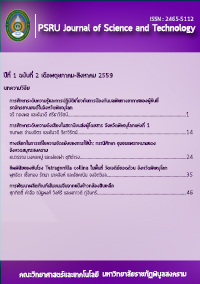ทางเลือกในการแก้ไขความขัดแย้งของการใช้น้ำ: กรณีศึกษา ชุมชนแพรกหนามแดง จังหวดสมุทรสงคราม
Keywords:
ทางเลือก, ความขัดแย้งในการใช้น้ำ, การจัดการน้ำแบบบูรณาการ, ชุมชนแพรก, หนามแดง, สมุทรสงครามAbstract
งานวิจัยนี้มีวัตถุประสงค์เพื่อสร้างทางเลือกในการแก้ไขความขัดแย้งของการใช้น้ำ ในชุมชนแพรกหนามแดง จังหวัดสมุทรสงคราม โดยมีการระบุผู้มีส่วนเกี่ยวข้องหลักที่ควรมีบทบาทในการตัดสินใจ รวมทั้งระบุปัญหาที่เกิดขึ้นจริงในพื้นที่ วิธีการศึกษาประกอบด้วยการวิเคราะห์ผู้มีส่วนเกี่ยวข้องด้วยวิธีเมตริกซ์ระหว่างความสำคัญ-อิทธิพล การสนทนากลุ่ม แบบสอบถาม และการสัมภาษณ์เชิงลึก ซึ่งผลการศึกษา พบว่า ผู้มีส่วนเกี่ยวข้องหลัก ได้แก่ เกษตรกร เจ้าหน้าที่ส่วนท้องถิ่น และเจ้าหน้าที่จากกรมชลประทาน ปัญหาหลักที่ได้รับความสนใจ 3 อันดับแรก ได้แก่ ขยะและวัชพืชในคูคลอง การปนเปื้อนของสารพิษทางการเกษตร และการควบคุมประตูน้ำที่ไม่เหมาะสม ทางเลือกที่นำเสนอเกี่ยวข้องกับ 3 ประเด็นหลัก ได้แก่ ประตูน้ำและการควบคุมประตูน้ำ ของเสียและตะกอน และความร่วมมือระหว่างผู้เกี่ยวข้อง ทั้งนี้ ผู้มีส่วนเกี่ยวข้องแต่ละกลุ่มมีความคิดเห็นที่แตกต่างกันเกี่ยวกับประตูน้ำ โดยกลุ่มชาวนา ชาวสวน และฟาร์มกุ้งต้องการให้เปลี่ยนประตูน้ำเป็นรูปแบบที่ออกแบบโดยชาวบ้านทั้งหมด ในขณะที่กลุ่มผู้เลี้ยงปลาสลิด และเจ้าหน้าที่ของรัฐต้องการรักษาประตูน้ำในรูปแบบเดิมแต่ปรับปรุงรูปแบบการระบายน้ำ ผู้มีส่วนเกี่ยวข้องส่วนใหญ่เสนอให้มีการส่งเสริมการใช้สารสกัดจากธรรมชาติในการเกษตรเพื่อแก้ไขปัญหาการปนเปื้อนของสารพิษทางการเกษตร เข้มงวดในการบังคับใช้กฎหมายเกี่ยวกับการจัดการของเสียจากภาคอุตสาหกรรม กระตุ้นจิตสำนึกเกี่ยวกับการจัดการของเสียในชุมชน รวมทั้งให้มีการกำจัดตะกอนจากคูคลองอย่างสม่ำเสมอ นอกจากนี้ ควรส่งเสริมให้มีความร่วมมือระหว่างองค์กรที่เกี่ยวข้องและชุมชนเพื่อการจัดการน้ำอย่างยั่งยืนในพื้นที่ต่อไป
This research aimed to investigate feasible alternatives for solving the conflicts regarding the water uses in Phrak Nam Daeng Community, Samut Songkhram Province, Thailand. Key stakeholders who should be involved in decision making and the actual problems occurred were also identified. Stakeholder analysis by importance-influence matrix and means of focus group discussion, questionnaires and in-depth interviews were undertaken. Findings showed that key stakeholders included farmers, local administrations and the government officers from the irrigation section. Three most concerned problems were garbage and weed in the canals, toxic contamination from agriculture and the mis-control of the gates. Suggested alternatives involved three main issues i.e. the gates and control, waste and sediments, and collaboration among stakeholders. Different stakeholders preferred different gate options. Paddy field farmers, orchard and vegetable farmers and shrimp farmers highly preferred to change the design of the built gates to the locals’ design while snakeskin gourami fish aquaculture farmers and government officers preferred to keep all built gates but required improvement of the gates operation. The majority of stakeholders suggested an encouragement to use more bio-chemicals in the agricultural activities to solve toxic contamination from agriculture while preferred to restrict law enforcement about waste disposal for toxic contamination from industries. Most of key stakeholders preferred to promote local awareness on waste disposal and suggested to undertake regularly operation on the sediments removal from the canals. More importantly, collaboration between responsible organizations and locals should be developed for the most sustainable way of water management in the area.
Downloads
How to Cite
Issue
Section
License
กองบรรณาธิการขอสงวนสิทธิ์ในการปรับปรุงแก้ไขตัวอักษรและคำสะกดต่างๆ ที่ไม่ถูกต้อง และต้นฉบับที่ได้รับการตีพิมพ์ในวารสาร PSRU Journal of Science and Technology ถือเป็นกรรมสิทธิ์ของคณะวิทยาศาสตร์และเทคโนโลยี มหาวิทยาลัยราชภัฏพิบูลสงคราม และ
ผลการพิจารณาคัดเลือกบทความตีพิมพ์ในวารสารให้ถือมติของกองบรรณาธิการเป็นที่สิ้นสุด







